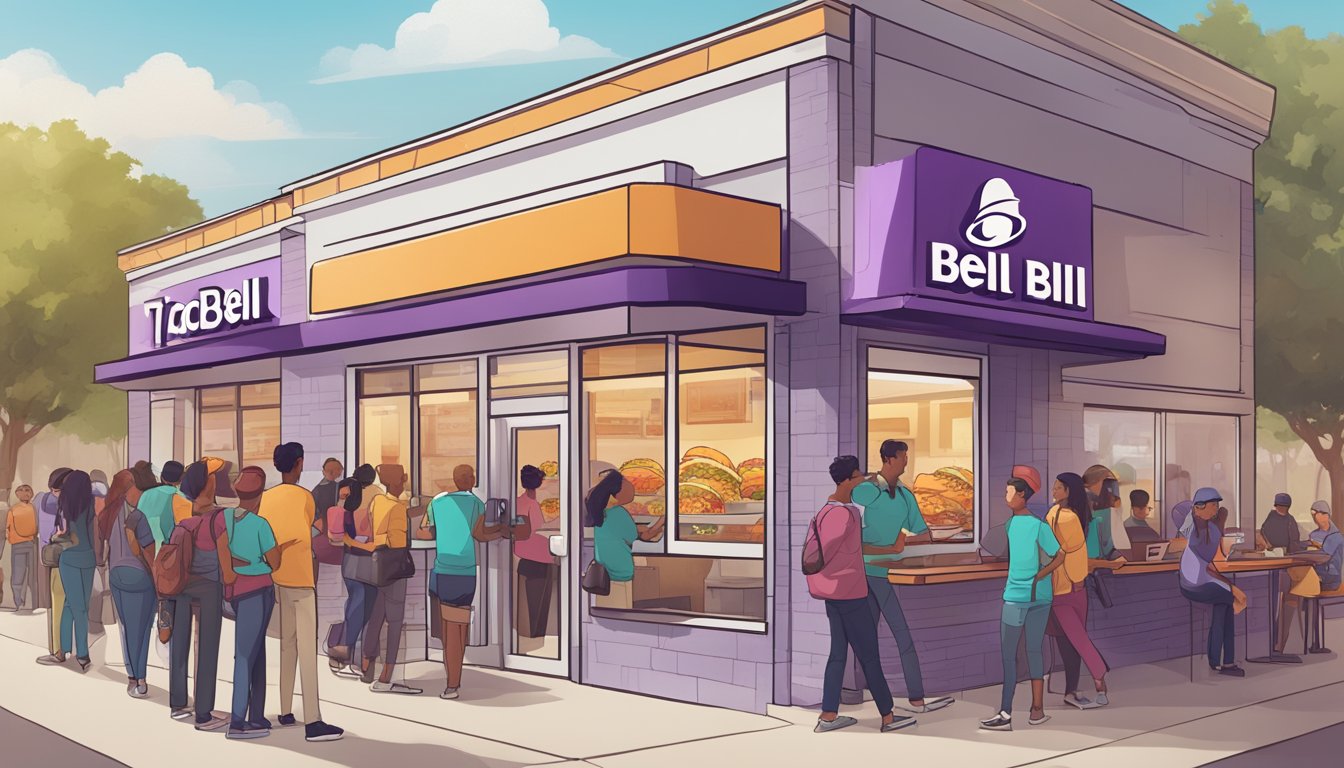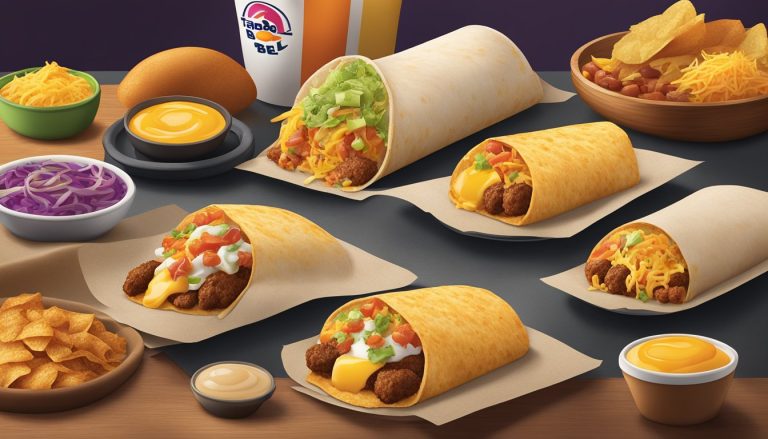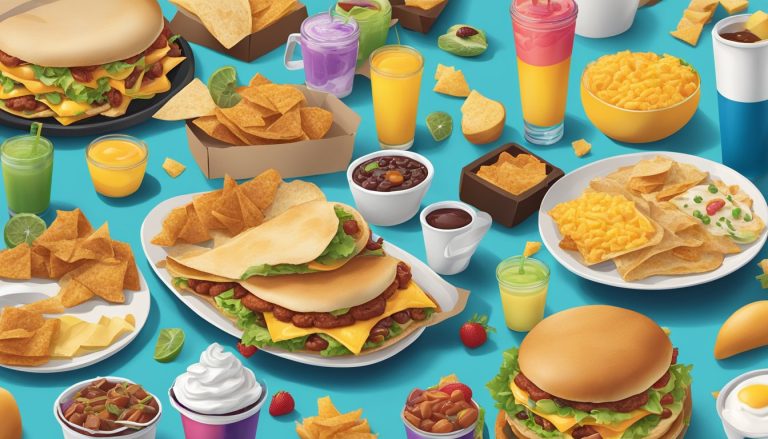Taco Bell has become a social media powerhouse in the fast food industry. The brand’s innovative approach to digital marketing has played a crucial role in its breakfast menu success. By leveraging platforms like Twitter, Facebook, and Instagram, Taco Bell has created buzz and engaged directly with customers in ways that resonate with its target audience.
Taco Bell’s social media strategy for breakfast focuses on creating shareable content, responding quickly to customer feedback, and launching creative campaigns that capture attention. This approach has allowed the company to build excitement around new breakfast items and drive foot traffic to its restaurants during morning hours. The brand’s willingness to take calculated risks with its online presence has paid off, resulting in increased brand awareness and customer loyalty.
Taco Bell’s social media success extends beyond just promoting its breakfast menu. The company uses its digital platforms to foster a sense of community among fans, encourage user-generated content, and even address customer service issues in real-time. This comprehensive social media strategy has helped Taco Bell stand out in a crowded fast food marketplace and solidify its position as a leader in social media marketing.
Taco Bell’s Breakfast Success: An Overview
Taco Bell’s entry into the breakfast market marked a significant milestone in the fast-food industry. The chain’s innovative approach and understanding of its target audience propelled its breakfast offerings to success.
Product Innovation and Menu Offerings
Taco Bell disrupted the breakfast scene with unique menu items that blended traditional morning fare with their signature Mexican-inspired flavors. The Breakfast Crunchwrap, a handheld tortilla filled with eggs, cheese, and hash browns, became an instant hit. Breakfast burritos and quesadillas offered familiar concepts with a Taco Bell twist.
The chain also introduced the Waffle Taco, a bold move that garnered significant attention. This item featured a folded waffle filled with sausage or bacon, eggs, and cheese. Taco Bell’s breakfast nachos provided a savory option for those seeking a non-traditional morning meal.
Product innovation extended to beverages as well. The Mountain Dew Kickstart Orange Citrus drink was specially crafted to complement the breakfast menu.
Understanding the Target Audience
Taco Bell’s breakfast success stemmed from its keen understanding of its core demographic. The chain targeted younger consumers, particularly millennials, who were open to non-traditional breakfast options.
Marketing campaigns like “Breakfast Defectors” encouraged customers to break away from conventional breakfast choices. This approach resonated with their audience’s desire for novelty and excitement in their dining experiences.
Taco Bell recognized that their target audience valued convenience and affordability. They ensured their breakfast menu was quick to prepare and priced competitively. The chain also extended breakfast hours to cater to late-risers and shift workers.
Social media played a crucial role in engaging with the target audience. Taco Bell used platforms like Twitter and Instagram to create buzz around their breakfast offerings and interact directly with customers.
Social Media’s Impact on Taco Bell’s Brand
Taco Bell has leveraged social media to transform its brand identity, engage customers, and launch viral campaigns. The fast food chain’s digital presence has become a key driver of its success and brand loyalty.
Brand Identity and Digital Presence
Taco Bell’s social media strategy has shaped a unique brand identity that resonates with younger audiences. The company embraces a playful, irreverent tone across platforms, setting it apart from competitors. This approach aligns with their “Live Mas” slogan, encouraging customers to live life to the fullest.
Their digital presence extends beyond traditional advertising, with witty posts and memes that spark conversations. Taco Bell’s social accounts often react quickly to pop culture events, keeping the brand relevant and top-of-mind for followers.
The launch of menu items like the Cool Ranch Doritos Locos Tacos generated significant buzz online. Taco Bell used social media to build anticipation and drive demand for these innovative products.
User-Generated Content and Community Engagement
Taco Bell actively encourages and shares user-generated content, fostering a sense of community among fans. Customers frequently post photos and videos of their Taco Bell experiences, which the brand reposts and engages with.
This strategy has created a loyal following of brand advocates who feel connected to Taco Bell. The company often responds to customer comments and suggestions, showing they value customer input.
Taco Bell’s social media team also uses platforms to gather feedback on new menu items and promotions. This direct line of communication helps the brand refine its offerings and marketing strategies.
Influencer Collaborations and Viral Campaigns
Taco Bell partners with influencers to amplify its message and reach new audiences. These collaborations often result in viral content that extends the brand’s reach organically.
One notable example is the partnership with pop star Doja Cat, positioned as an antihero of the brand. This unconventional approach generated significant buzz and aligned with Taco Bell’s edgy image.
The brand’s viral marketing campaigns often blend online and offline elements. Social media challenges, custom Snapchat filters, and Twitter contests encourage widespread participation and sharing.
These efforts have solidified Taco Bell’s reputation as a digital marketing innovator in the fast food industry. The brand’s social media success has become a benchmark for other companies seeking to engage younger consumers effectively.
Marketing Strategies That Resonate with Young Consumers
Taco Bell’s marketing approach targets millennials, teenagers, and young adults through tailored strategies. The brand focuses on segmentation, personalization, affordability, and strategic market positioning to connect with its core demographic.
Segmentation and Personalization
Taco Bell employs market segmentation to understand its young consumer base. The brand uses demographic and behavioral segmentation to tailor its offerings and messaging.
For millennials and Gen Z, Taco Bell creates personalized experiences through its mobile app. This technology allows for customized orders and targeted promotions based on individual preferences.
Social media plays a crucial role in Taco Bell’s segmentation strategy. The brand adapts its content for different platforms, ensuring it speaks the language of each segment.
Affordability and Market Positioning
Taco Bell positions itself as an affordable option for young consumers. The brand’s value menu and combo deals appeal to budget-conscious millennials and students.
Price-sensitive marketing campaigns highlight Taco Bell’s cost-effective offerings. This approach resonates with young adults who seek quality food at accessible prices.
Taco Bell’s market positioning emphasizes innovation and uniqueness. The brand introduces limited-time items and collaborations that generate buzz among its target demographic.
By maintaining a balance between affordability and novelty, Taco Bell creates a strong value proposition for young consumers.
Leveraging Technology for Enhanced Customer Experience
Taco Bell has embraced digital innovation to elevate its customer experience. The fast-food chain utilizes mobile technology and online platforms to streamline ordering processes and cater to individual preferences.
Mobile App and Online Convenience
Taco Bell’s mobile app stands at the forefront of its digital strategy. The app allows customers to browse menus, place orders, and pay with ease. It also features exclusive deals and promotions, incentivizing app usage.
Drive-thru experiences have been enhanced through digital menu boards and voice-activated ordering systems. These technologies reduce wait times and improve order accuracy.
The app’s GPS functionality enables customers to check in upon arrival, ensuring their food is prepared fresh and ready for pickup. This seamless integration of mobile technology with physical locations boosts customer satisfaction and operational efficiency.
Customization Through Digital Channels
Taco Bell’s digital platforms empower customers to tailor their meals. The mobile app and website offer intuitive interfaces for customizing ingredients, portion sizes, and dietary preferences.
This personalization extends to the company’s digital marketing efforts. Taco Bell uses data analytics to send targeted promotions and recommendations based on individual ordering history.
The chain’s loyalty program, integrated into its digital ecosystem, rewards frequent customers with points and exclusive offers. This data-driven approach helps Taco Bell build stronger relationships with its customer base.
Digital channels also facilitate quick feedback collection, allowing Taco Bell to rapidly iterate and improve its menu offerings and service quality.
Building Community and Fostering Engagement
Taco Bell leverages social media to create a vibrant community of loyal customers. The brand’s digital strategies focus on interactive promotions and responsive customer service to drive engagement.
Promotions and Customer Incentives
Taco Bell’s social media campaigns often include enticing promotions and incentives. The company frequently runs contests, offering free menu items or exclusive merchandise to participants. These initiatives encourage customers to interact with the brand online and share content.
Taco Bell’s “Feed the Beat” program supports emerging musicians, creating goodwill and expanding its reach to new audiences. This initiative aligns with the brand’s youthful image and fosters a sense of community among music lovers.
The chain also uses time-sensitive offers, like limited-time menu items, to create buzz and drive foot traffic. These promotions are heavily promoted across social platforms, sparking conversations and increasing brand visibility.
Managing Online Communities and Customer Feedback
Taco Bell actively monitors and responds to customer feedback on social media. The brand’s social media team engages with followers, addressing concerns and sharing positive experiences.
The company employs social listening tools to track mentions and sentiment across platforms. This data informs marketing strategies and helps identify areas for improvement in products and services.
Taco Bell encourages user-generated content, reposting customer photos and videos. This approach makes followers feel valued and strengthens the connection between the brand and its community.
The brand maintains a consistent voice across platforms, using humor and trendy language to resonate with its target audience. This strategy has helped Taco Bell build a distinctive online personality that fans relate to and engage with regularly.
Strategic Partnerships and Co-Branding Efforts

Taco Bell has leveraged strategic partnerships and innovative co-branding campaigns to amplify its marketing reach and create unique product offerings. These collaborations have played a crucial role in expanding the brand’s appeal and driving customer engagement.
Collaborations with Popular Brands
Taco Bell’s partnerships with well-known brands have been instrumental in its marketing success. The fast-food chain has teamed up with Doritos, a division of Frito-Lay, to create the wildly popular Doritos Locos Tacos. This collaboration merged Taco Bell’s signature tacos with Doritos’ iconic flavored shells.
The partnership resulted in over 1 billion units sold within the first year of launch. Taco Bell has also collaborated with other brands like Mountain Dew to create exclusive beverages, further enhancing its menu offerings and attracting new customers.
Innovative Co-Branding Campaigns
Taco Bell’s co-branding efforts extend beyond product collaborations to include creative marketing campaigns. The brand has partnered with clothing retailers to launch limited-edition apparel lines, generating buzz and strengthening brand loyalty among younger consumers.
In 2021, Taco Bell collaborated with Lil Nas X, naming him Chief Impact Officer. This partnership included exclusive menu items and promotional content, leveraging the artist’s popularity to reach new audiences. Such innovative campaigns have helped Taco Bell maintain its position as a trendsetter in fast-food marketing.
Evaluating Taco Bell’s Global Reach and Adaptation
Taco Bell has expanded its presence beyond the United States, adapting its menu and marketing strategies to suit local tastes and preferences. The fast-food chain’s global expansion efforts have focused on introducing Mexican-inspired cuisine to new markets while tailoring offerings to each region.
Cultural Adaptation in International Markets
Taco Bell modifies its menu to align with local culinary preferences and dietary restrictions. In India, the chain offers vegetarian options and avoids beef products to respect religious beliefs. The UK menu features exclusive items like the Chickstar Wrap, catering to British tastes. In Japan, Taco Bell introduced wasabi-flavored menu items to appeal to local palates.
The company also adjusts its marketing strategies to resonate with different cultures. In Spain, Taco Bell emphasizes its American roots to differentiate itself from local Mexican restaurants. The brand uses local celebrities and influencers in various countries to build brand recognition and trust.
Expansion Strategies and Global Presence
Taco Bell’s international growth relies on strategic partnerships and franchising agreements. The company enters new markets through master franchise agreements with experienced local operators. This approach allows for rapid expansion while leveraging local market knowledge.
As of 2025, Taco Bell operates in over 30 countries across Europe, Asia, and Latin America. Key markets include the United Kingdom, Spain, India, and China. The chain aims to reach 1,000 international locations by 2030.
Taco Bell adapts its restaurant designs to suit local preferences. In urban Asian markets, the company focuses on smaller footprint stores. In contrast, European locations often feature larger dining areas and alcohol service to align with local dining habits.
The Future of Taco Bell’s Social Media Strategy
Taco Bell’s social media strategy will continue evolving to stay ahead of consumer trends and technology shifts. The brand aims to maintain its innovative edge while deepening connections with customers.
Adapting to New Trends and Platforms
Taco Bell will likely explore emerging social platforms to reach new audiences. The company may experiment with augmented reality filters and interactive games to showcase menu items like Nacho Fries. Short-form video content on TikTok and Instagram Reels could highlight unique dining experiences and behind-the-scenes glimpses.
Taco Bell may leverage AI-powered chatbots for personalized customer interactions. These could provide menu recommendations based on dietary preferences, including vegetarian and vegan options.
Sustaining Growth through Continuous Innovation
Menu innovation will remain central to Taco Bell’s social strategy. The brand may use social media polls and contests to involve fans in new product development. Live-streaming cooking demonstrations could feature chefs creating limited-time offerings.
Taco Bell might expand its use of influencer partnerships, collaborating with food bloggers and lifestyle creators. These collaborations could spotlight the brand’s commitment to offering unique dining experiences and diverse menu options.
Gamification elements, such as virtual loyalty programs or digital collectibles, may be introduced to boost engagement and drive sales through social channels.




